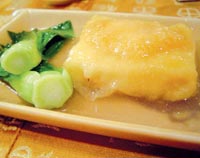 Summer is the season for Chinese to attend to body restoration and
nourishment. People usually emphasize diet to withstand the torrid weather and
lessen fatigue.
Summer is the season for Chinese to attend to body restoration and
nourishment. People usually emphasize diet to withstand the torrid weather and
lessen fatigue.
For the same reason, tonics are important in summer. Among all kinds of
restoratives,ginseng is perhaps the most popular in the country and Asia for its
amazing curative properties. Ginseng was discovered in China as early as some
3,000 years ago and in ancient times it was appreciated as a panacea because its
roots were shaped like the human body and commonly lived for as long as a
century.
What happens when the Chinese cuisine meets with ginseng, especially the
exotic variety?
Recently, I attended a ginseng-themed banquet at a local four-star hotel.
Every dish in the dinner was made with ginseng from Wisconsin in the United
States.
The menu looked like a funny family tree under the same family name: Bean
with Wisconsin Ginseng, Conch salad with Wisconsin Ginseng, Sauteed shrimp with
Wisconsin Ginseng and even Baked egg tarlet with Wisconsin Ginseng. The names
did not stimulate my appetite but made me feel energetic and excited even before
sampling those ginseng-laced foods.
The food was quite to my taste, mild and not greasy at all, which is just the
right way to eat on hot days. One of my favourite dishes was the Laver rolls
which contained vegetables, a little meat and sliced ginseng (20 yuan, US$2.5).
The flavour was unlike all the other kinds of laver rolls I had eaten before,
mildly sweet and also somewhat bitter due to the ginseng, with a herbal aroma.
 The chef even put ginseng in the lotus root stuffed with glutinous rice (20
yuan, US$2.5), which is a traditional Chinese dish known for its sweet taste.
The natural ginseng flavour was covered by the lotus root's sweetness and melded
into the soft glutinous rice.
The chef even put ginseng in the lotus root stuffed with glutinous rice (20
yuan, US$2.5), which is a traditional Chinese dish known for its sweet taste.
The natural ginseng flavour was covered by the lotus root's sweetness and melded
into the soft glutinous rice.
Despite its unimpressive presentation,the river perch jelly with ginseng (26
yuan, US$3.25) had a cool and refreshing taste.
Soup called Double-boiled beef with Wisconsin Ginseng and watercress (18 yuan
per serving, US$2.25) followed the cold dishes. The broth was tasty and rich,and
properly absorbed the flavours of the different ingredients while the beef was
tender and delicate.
In China, it is common to put ginseng into soups for the nutrition and scent.
I prefer this kind of preparation because diners do not need to chew the
ginseng, which itself is usually bitter and hard to digest.
According to the chef named Huang Haifei, the beef was first steamed for
about one hour and after being seasoned it wascooked again with watercress for
about 25 minutes.
"Ginseng slices were put into the soup in the last 20 minutes. And the
ginseng used in all dishes have been macerated and steamed for about 15 minutes
before being mixed with other ingredients," said Huang."Even the water in which
the ginseng was steamed is used in some dishes to highlight the ginseng
flavour."
After trying a few shrimp, scallop,chicken and fish dishes cooked with
ginseng,a deep-fried bean curd with ginseng(28 yuan, US$3.5) greatly pleased my
palate. Despite its small portion, the beancurd contained a shrimp ball, sliced
vegetables and ginseng was fried to a lovely goldenyellow colour. The dish
tasted somewhat bland like others and the integrated flavour of beancurd, shrimp
and ginseng was harmonious and delicate.
Huang said a piece of beancurd, with the other ingredients inside was first
fried and then stewed in a broth containing the ginseng water. In this way,the
beancurd fully absorbs the flavour and nutrition of ginseng.
All the dishes featuring the Wisconsin Ginseng are available in the Courtyard
Marriott Hotel in Pudong for the next three months, mostly at a reasonable
prize.
Courtyard Marriott Hotel
Location: No.838
Dongfang Road
Tel: 021-388744500